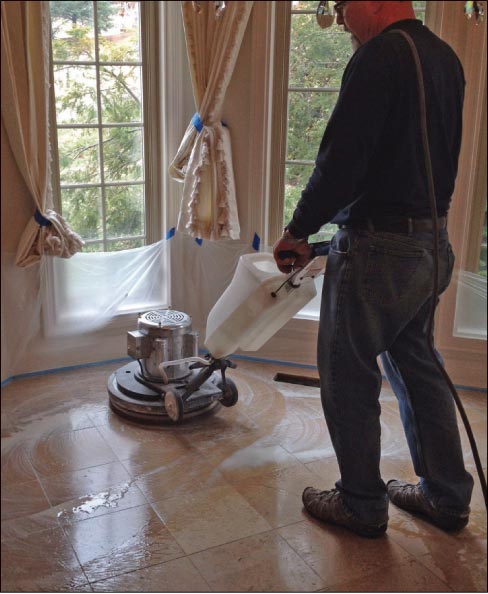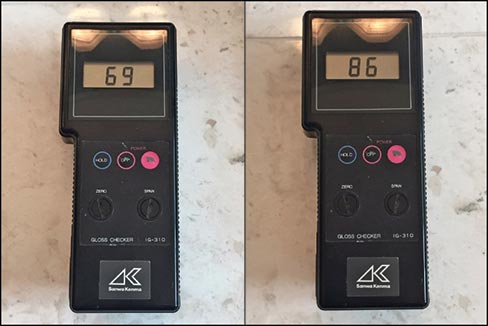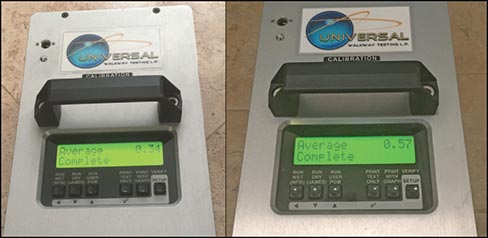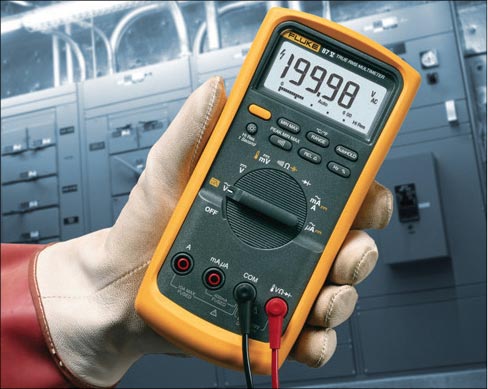Stone Restoration and Maintenance Corner: Essential, Dual Purpose Equipment
Bob Murrell
Special Contributor
Photos provided by Bob Murrell
 |
|
Above: A single disc, slow speed machine (150-300 rpm) like the Mastercraft Quarry Master is useful for polishing smaller spaces like bathrooms and vestibules, stairs, and other horizontal surfaces. |
 |
|
Above: A gloss meter is an essential piece of equipment to evaluate your progress on a job, whether maintenance or restoration. Gloss meter readings before (left) and after (right) polishing. |
 |
|
Above: Slip coefficient measuring made simple: BOT 3000 SCOF readings – At Left, .34, and at right, exceeding the OSHA standard of .5. |
 |
|
You should always bring a multimeter on the jobsite for checking voltage, amps, and resistance. The principal reason to check voltage is to assure proper machine supply and troubleshoot any other electrical issues. |
Part of the restoration and maintenance professional’s tools is the equipment he needs to complete certain tasks and / or procedures. There are many types of floor machines or better termed, machines for doing floors. There are machines for maintenance and there are machines for restoration. Sometimes the same machines can accomplish different tasks, or can be used for both of these two applications.
A particular process usually determines the need for a specific machine. For example, heavy grinding of a large square footage project may require the use of a planetary head machine for the best efficiency. As previously discussed, planetary head machines are much more effective when it comes to lippage removal (grinding), honing, and other heavy stock removal applications on most stone, terrazzo, and concrete floors.
Planetary machines can be standard single disc machines outfitted with an optional planetary drive system all the way up to 3 phase, radio/remote control, variable speed/drive, 500 kg or more machines. There are even Bobcat type machines fitted with several of the three-headed planetary machines and still larger equipment that resembles a large Zamboni (an ice rink resurfacing machine, in case you didn’t already know).
In many situations a single disc slow speed (150-300 rpm) machine in either the 17 inch or 20 inch size, is the tool of choice. Especially for polishing procedures, these machines can provide superior results. Of course to increase production with this setup, simply add machines and people. These machines can be very handy as they normally only require 110v power which is common most everywhere in North America. Smaller diameter slow speed machines are also very useful for bathrooms and vestibules, stairs, and other horizontal surfaces.
One of my favorite floor machines is a planetary polisher and yet requires only normal 110v power. They are strong and reliable. I have personally used and demonstrated these machines for well over 20 years with great success and no major negative issues of any kind. I like both the Majestic Heavy Duty machine as well as the Mastercraft Quarry Master when it comes to single disc slow speed machines. They are both made in the USA and perform reliably under harsh restoration conditions, which is a must. They are available with either modern dual capacitor AC or DC rectified motors. Each has their own advantage, and this is a personal preference. Talk with your supplier to determine which is best for you.
There are also other pieces of equipment which are used in routine maintenance such as high speed burnishers, auto-scrubbers, and floor (carpet type) driers which are among some of the machines that come to mind.
Burnishers are high-speed machines typically used in combination with white pads or diamond impregnated pads to brighten and render surfaces more consistent looking.
Burnisher speed is typically between 1,000-2,000 rpm. Finishing each project with a burnisher and a white pad most always improves the overall results and appearance.
Auto-scrubbers and ride-on scrubbers are wet operation maintenance machines used for typically keeping large scale project surfaces clean and healthy. They utilize non-woven pads, diamond impregnated pads, or even brushes (for the cleaning of grout and textured surfaces).
Of course hand tools are required to complete many projects. Doing the borders against the walls are some of the toughest parts of a job. Commercial quality right angle grinder/polishers are an absolute necessity. Once again, speed control is essential for different aspects of the procedure. Grinding and honing can be accomplished quicker at higher speeds like 1,500 - 4,000 rpm, while polishing provides the best results slowing the machine down to below 1,000 rpm. I like the Flex and Makita brand tools for these operations, and they have suited me very well over the years. There are also small upright border/edge machines available for large projects.
Whether using floor machines or hand tools, working wet or dry also comes into play. Dry operations will probably require the use of a dust collar or shroud in combination with a dust extractor (dry filter vac). Wet operations require the use of a wet vac and draping or taping to protect adjacent or sensitive areas.
Use of a gloss meter is very beneficial to help customers see before and after definitive results. This is especially true when polishing is a specific component of the job process. A gloss meter can physically put into perspective the jump in light reflection and help a client understand what has occurred during the honing and polishing processes. It can also be used to make sure you meet a goal agreed upon by all parties.
Slip/fall concerns are a fast growing interest for hard floor surfaces, mostly in commercial applications subject to the public or large amounts of pedestrians. Casinos, airports, hospitals and schools come to mind, to name just a few.
The static (SCOF), and sometimes the dynamic (DCOF), coefficient of friction are used to quantify the slip resistance of a surface. I own and have experience with two types of slip coefficient measuring device, the manual pull meter and the robotic BOT 3000. Both work well, but the BOT 3000 is subject to less human interpretation and therefore normally more accurate. It is also much more expensive to own and operate. As of 2013 the Occupational Safety and Health Administration recommends that walking surfaces have a SCOF of .5. However, there may be circumstances that require a higher reading.
I know that I have not mentioned all of the possible pieces of equipment used in the industry and forgive me if I have not mentioned anyone’s favorite machine.
There are plenty of other pieces of equipment that will be needed from time to time. Portable lighting, moisture meters, multimeters (for testing voltage and amperage), pressure washers and the list goes on and on. Each company will need to do their own assessment of what equipment will be required for their focused applications. As always I suggest that you consult with a reputable distributor and solicit their input for product equipment suggestions and options. Of course ultimately, the types and brand choices are your decision as the owner of the company.
Bob Murrell has worked in the natural stone industry for over 40 years and is well known for his expertise in the restoration and maintenance of natural stone, terrazzo, ceramic tile, and decorative concretes. He helped develop some of the main products and processes which revolutionized the industry. Bob started one of the largest and most successful training seminars in the industry with thousands of contractors having attended his school over a 25-year period. He is currently the National Sales Manager for M3 Technologies based out of Cohasset, Massachusetts.